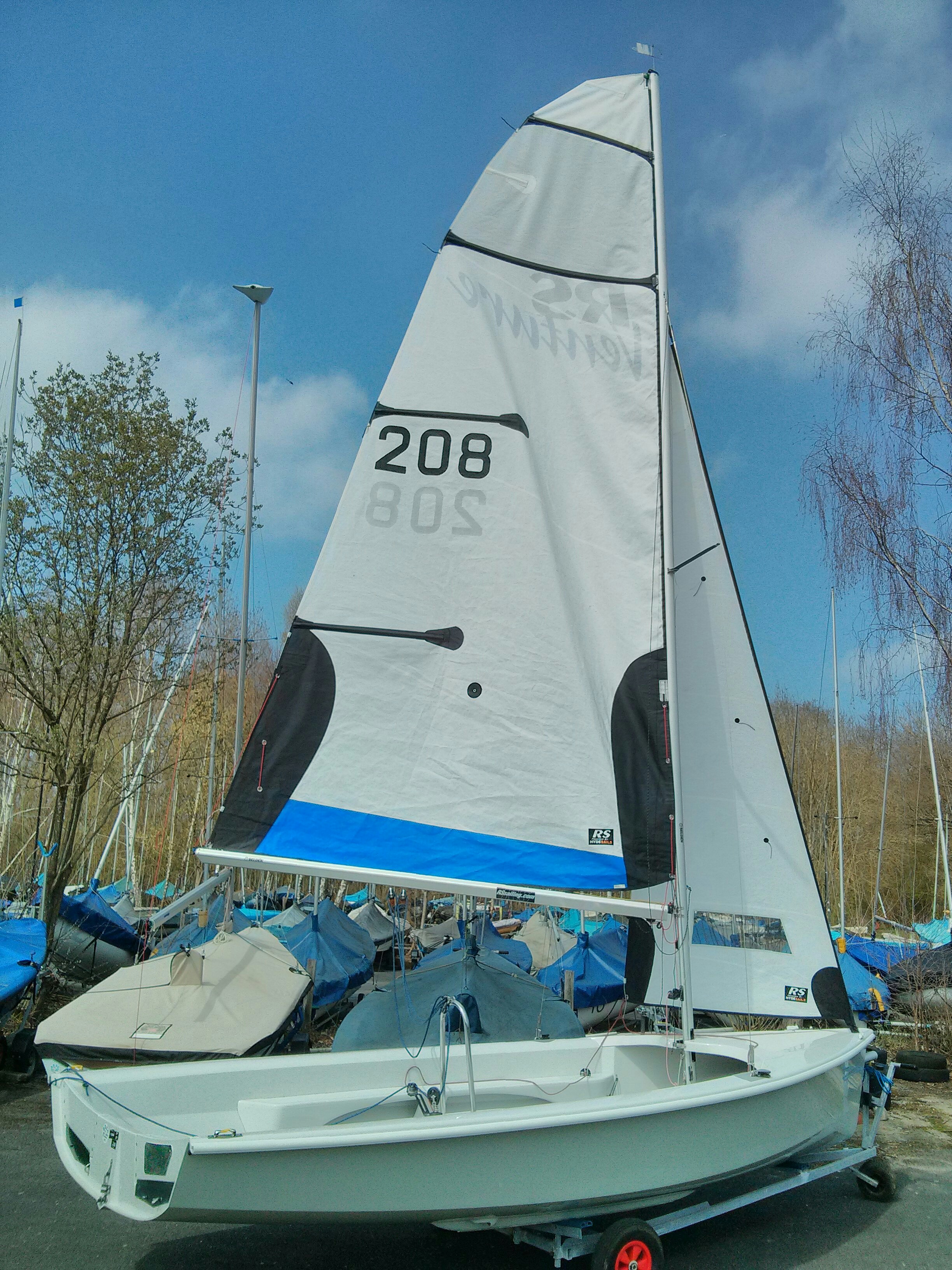Rigging the RS Venture Jib
Overview and Tips before you start
When rigging the boat, the Jib is always rigged first as this provides support to the mast. Turn the bow of the boat directly into the wind before you start.
The Jib wire that runs internally up the mast, serves two purposes. The most obvious is to support the Jib sail that balances and enhances the performance of the mainsail. The second purpose is to provide tension and support to the mast when under sail.
The tension is provided by the Jib wire that consists, at its mast end, of a rope tail spliced to a wire loop. At its upper end it terminates in a spinner coupling to which the Jib sail wire is shackled. The lower end of the Jib wire is connected to the furler sited in the bow under the chute. The RS Venture offers the facility to furl the Jib Sail, extremely useful in windy conditions but has the additional complexity of needing a furler unit and spinner couplings to enable the sail to be furled without damaging the Jib wire. The Jib wire assembly is part of the ‘standard rigging’ ie the wire and rope etc that are usually left in the mast /boat when not being sailed. Note that as soon as the boat is brought ashore the forestay wire should be attached to the foredeck fastening and the jib tension should be eased.
After sailing the Jib sail, complete with its wire, should be removed from the spinner and the bow furler unit, dried and stored. If sailed in salt water a brief hose down to remove the salt crystals is advisable before storage. Sails are expensive so worth a little care and attention.
Start Rigging
Before connecting the Jib sail check that the Bow furler drum is fully rewound. Failure to do so may result in the Jib not being able to be fully furled or unfurled. Remove the Jib sail from its bag and unroll it across the deck to avoid putting unnecessary creases in the sail.
The first task is to connect the Tack of the Jib sail to the furler unit. The coupling is sited in the bow and is made using a ‘D’ shackle - see the image of the coupling. Unlike many dinghies the RS Venture jib sail has a canvas tail at its tack that does much to protect the gennaker sail from damage by the furler unit coupling. The pin at the top of the furler unit should be well taped. Make the coupling and attach the velcro wrap ensuring that it will fully protect the fragile gennaker sail from snagging on the coupling. reinforced canvas tail
The Head of the Jib sail is fastened to the spinner coupling at the upper end of the Jib wire. The spinner coupling should be kept clean and lubricated (use a PTFE lubricant) and should turn freely. If the spinner fails to spin freely when the furler unit is operated the Jib wire may be damaged (the fine wires will begin to fracture). The spinner coupling should be firmly taped to prevent damage to the gennaker. Alternatively make a tight fitting collar of wide knicker elastic to slide onto the coupling or use a short length of foam rubber handlebar grip, these this can be used many times over and remove the need for frequent taping.
Setting of the Jib sail is done by pulling on the Jib rope tail until the Jib wire loop appears from the slot at the rear of the mast. Pass the Jib wire tension hook under the mast gate, or release the mast gate to enable the tension hook and its tackle to lay flush against the mast. Taking great care not to trap the rope tail, hook the Jib tensioning pulley block system on to the Jib wire loop. If the hook traps the rope tail against the wire the rope will be cut through or badly damaged. Grip the Jib tensioning rope, preferably with gloves, and pull firmly until the Jib wire is taut (can be lightly pinged).
Jib sheet rigging
Complete rigging the Jib by tying a 'Crows foot' knot on to the clew of the jib. To do this, fold the Jib sheet at its centre and pass the loop through the clew cringle. Take the ends of the Jib sheet and pass them both through the loop in the Jib sheet. Snug the knot evenly on to the sail. Pass the ends of the Jib sheets either side of the mast and feed into the port and starboard jib cleats. Knot the end of each jib sheet to make sure the sheets do not pull clear of the cleats. A common and often convenient practice is to tie the ends of the sheets together – simplifies the tacking/crewing procedure when sailing. Use a Double fishermans Bend knot to secure the sheet ends together as this will rarely come adrift - pull this knot tight.
Finally the forestay can now be removed from its fastening on the foredeck and stored at the side of the mast. A bungee gripper around the mast is useful to keep the forestay out of the way whilst sailing, alternatively it may be stored by passing it down through the mast gate and trapping the line firmly against the mast using bungee ring or similar to keep it from fouling the jib during tacking manoeuvres.
